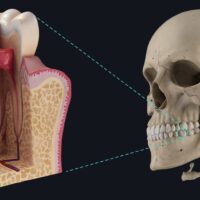What is buck teeth? Buck teeth, or protruding front teeth, are a dental condition characterized by the upper teeth extending beyond the lower set. This particular bite issue is often called an overbite. The prominence of these protrusive front teeth can lead to various challenges in eating and speaking and an increased vulnerability to discomfort and injury.
The condition of buck teeth can manifest at any stage of life, from early childhood to adulthood, and may have different underlying causes. Fortunately, treatment options are available to address this dental concern, aiming to improve oral health and aesthetics. One common approach dental specialists employ is orthodontic treatment, which involves using braces or other corrective devices.
Orthodontic treatment for buck teeth aims to realign the teeth, bringing them into the proper position and improving their functionality. By applying consistent pressure to the teeth over time, braces gradually shift the misaligned teeth to their desired location. This treatment option addresses the potential health issues associated with buck teeth and enhances the overall appearance of the person’s smile.
Correcting buck teeth can positively impact an individual’s oral health. Aligned teeth make it easier to chew food properly and speak without impediments. Additionally, treating buck teeth can prevent potential complications, such as excessive wear on the teeth, gum problems, and even temporomandibular joint (TMJ) disorders.
What Is Buck Teeth? Proper Definition
Buck teeth, also known as an overbite, happen when the upper front teeth stick out in front of the lower front teeth. This dental condition can vary in severity and is primarily a cosmetic issue affecting a person’s confidence in smiling.
For some individuals, having buck teeth may not bother them much, so they choose not to seek treatment. However, others may experience functional difficulties and require treatment. These functional problems can include unintentionally biting the tongue, other teeth, or gums, leading to damage.
Imagine a scenario where the upper front teeth are like eager explorers venturing out ahead of the lower teeth. This misalignment is what we call buck teeth. It’s like having a hill-shaped formation in the mouth, where the upper teeth proudly occupy the forefront.
While some people embrace their buck teeth, seeing them as unique or endearing, others may feel self-conscious about their appearance. They may hesitate to smile fully or openly, worried that their protruding teeth will be the center of attention.
Although buck teeth are primarily cosmetic, they can also cause functional issues. Think about accidentally biting your tongue while chewing or speaking. Ouch! It can be quite uncomfortable and may even lead to injuries in the mouth. Additionally, the upper teeth might clash against the lower teeth, causing damage to both sets. Furthermore, the gums may suffer from repeated irritation due to the misalignment.
Therefore, it’s essential to consider both the aesthetic and functional aspects when deciding whether or not to seek treatment for buck teeth. While some may find their buck teeth charming or inconsequential, others may experience difficulties that warrant dental intervention to ensure their oral health and overall well-being.
Causes of Buck Teeth
After getting knowledge about the question: what is buck teeth? Now it’s time to discuss buck teeth causes. Buck teeth, or protrusive teeth, can occur for various reasons, influenced by genetics and environmental factors.
One common cause of buck teeth is the habit of sucking thumbs or fingers or prolonged use of pacifiers, especially after age 5. When children have permanent teeth, thumb sucking can affect their teeth’ alignment, leading to buck teeth’ development. It can also impact the normal growth of the mouth and change the shape of the roof of the mouth.
Another potential cause of misaligned teeth, or malocclusion, is mouth injury, which can result in jaw and teeth misalignment. Additionally, if one of the biological parents has protrusive teeth, it can be passed down through genetics and contribute to their child’s development of buck teeth.
Habits like tongue thrusting, where the tongue pushes against the front teeth when swallowing, can also contribute to the protrusion of teeth. Similarly, missing or crowded teeth can disrupt the proper alignment, causing some teeth to stick out.
Bruxism, which refers to grinding or clenching of the teeth, is another factor that can lead to buck teeth. The continuous pressure exerted on the teeth can gradually affect their positioning and cause protrusion.
Lastly, the shape or presence of impacted teeth, which do not fully emerge or grow unusually, can also contribute to the development of buck teeth.



